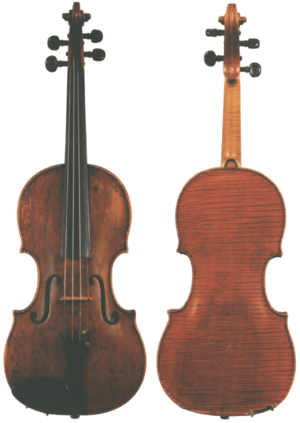Thomas Molineux (luthier) facts for kids
Quick facts for kids
Thomas Molineux
|
|
|---|---|
| Tomás Ó Maoileagáin | |

Violin by Molineux, c. 1750
|
|
| Born | c. 1700 |
| Died | 25 January 1757 Dublin, Ireland
|
| Known for | Luthier |
|
Notable work
|
violin, NMI collection |
| Style | Italian style |
| Movement | Irish school |
Thomas Molineux (born around 1700, died January 25, 1757) was a famous Irish luthier from Dublin. A luthier is someone who makes or repairs string instruments like violins. He made violins that are still around today. One of his violins is kept in the National Museum of Ireland in Dublin. His instruments are some of the oldest Irish violins we still have.
Contents
Who Was Thomas Molineux?
We don't know much about Thomas Molineux's early life. He was likely born before the year 1700. Some experts thought he might have been from another country. They believed he settled in Dublin when he was young. Others suggested he might have been from a group called Huguenots.
However, the name Molineux was common in Dublin and County Laois in the 1600s and 1700s. It's most likely that Molineux came from a family connected to the Church of Ireland. Many Irish luthier families at that time, like the Delanys and Perrys, were from Dublin or had roots in County Laois. These families often lived near each other. This might explain why many of them became violin makers in the same part of Dublin.
Becoming a Violin Maker
Learning the Craft: 1710–1739
Thomas Molineux probably started learning his trade around age 14. This training, called an apprenticeship, usually lasted at least seven years. This was a rule set by the Carpenters' Guild in Dublin back then.
His earliest known violin is from 1739. This suggests he trained between 1710 and 1739. He likely learned in an area of Dublin called Christchurch Yard. This area is now part of Christ Church Cathedral. Many violin makers worked there during those years.
One possible teacher was John Neal. He made instruments and sold music in Christchurch Lane. He worked there from 1701 to 1721. Then he moved to Christchurch Yard, working there until 1740. John Neal is thought to be the first known violin maker in Ireland. Another possible teacher was Thomas Dunn, who also made violins in Christchurch Lane in 1740. Sadly, none of their violins exist today. So, we can't compare their styles to Molineux's.
Molineux's earliest known violin was made in 1739. It was once called an "Irish Division Viol." People believe Molineux was making instruments even before this date. He worked in a part of Christchurch Yard known as 'Hell'. This was because of a carving of the devil above an archway. Despite its name, 'Hell' was a lively place. It had toy shops, taverns, and places to stay. This area became famous for violin making in the 1700s. Other famous luthier families, like the Neals and Wards, also worked there.
Later Work: 1740–1757
Some historians think Molineux might have taught another famous Dublin luthier, Thomas Perry. However, their violins look quite different. Perry's early instruments were similar to those made by Jacob Stainer. Molineux's instruments had an Italian style.
Perry and his father, John, were also luthiers in Christchurch Yard by 1760. So, Molineux probably knew them. Another idea is that Molineux taught George Ward. Ward's instruments are more like Perry's. Ward also started his business in Christchurch Yard. It's possible he learned from Molineux. Ward also branded his instruments on the back, just like Molineux did.
Molineux had a son named Martyn. Martyn also became a well-known violin maker in Dublin. He might have learned from his father or another luthier nearby. Thomas Molineux passed away on January 25, 1757. His death was noted in Faulkner's Dublin Journal. It read: "Death: In Christchurch-yard, Mr. Thomas Molineaux, Fiddle-maker."
Molineux's Violin Style
Molineux's violins are known for their Italian style. We don't know if he studied Italian instruments directly. He might have learned this style from his own teacher. Whether he was the first to use this style in Ireland or not, this Italian influence became very important. It shaped the "Irish school" of violin-making for the next 100 years.
Experts describe Molineux as a "confident maker." They say his instruments have "capital design" and "refined workmanship." This means they were very well made and looked great.
Molineux put his name on his instruments. He branded them 'MOLINEUX/DUBLIN' on the back, below the button. Many Irish luthiers after him copied this. It became a special mark of the Irish school. We don't know if he learned this from his teacher. He might have seen it on instruments by makers like Jacob Stainer. Or it could have come from another instrument-making tradition, like pipemaking.
|
|||||||||||||||||||||||||||||||||||||||||||||||||||||||||||||||||||||||||||||||||||||||||||||||||||||||||||||||||||||||||||||||||||||||||||||||||||||||||||||||||||||||||||||||||||||||||||||||||||||||||||||||||||||||||||||||||||||||||||||||||||||||||||||||||||||||||||||||||||||||||||||||||||||||||||||||||||||||||||||||||||||||||||||||||||||||||||||||||||||||||||||||||||||||||||||||||||||||||||||||||||||||||||||||||||||||||||||||||||||||||||||||||||||||||||||||||||||||||||||||||||||||||||||||||||||||||||||||||||
|
|||||||||||||||||||||||||||||||||||||||||||||||||||||||||||||||||||||||||||||||||||||||||||||||||||||||||||||||||||||||||||||||||||||||||||||||||||||||||||||||||||||||||||||||||||||||||||||||||||||||||||||||||||||||||||||||||||||||||||||||||||||||||||||||||||||||||||||||||||||||||||||||||||||||||||||||||||||||||||||||||||||||||||||||||||||||||||||||||||||||||||||||||||||||||||||||||||||||||||||||||||||||||||||||||||||||||||||||||||||||||||||||||||||||||||||||||||||||||||||||||||||||||||||||||||||||||||||||||||
Molineux's Surviving Instruments
We don't know how many instruments Thomas Molineux made. One of his best violins is kept in the National Museum of Ireland. It's part of a collection of musical instruments made by Irish craftsmen. This collection also includes instruments by John Delany, John Mackintosh, Thomas Perry, and George Ward.
Here are some of Molineux's instruments that still exist:
- 1739: This is the earliest violin we know of. It is in a private collection.
- (?): A violin branded 'MOLINEUX/DUBLIN'. It is in a private collection.
- (?): A violin kept at the National Museum of Ireland in Dublin.
See also
- Thomas Perry (Irish luthier)
- George Ward (Irish luthier)

